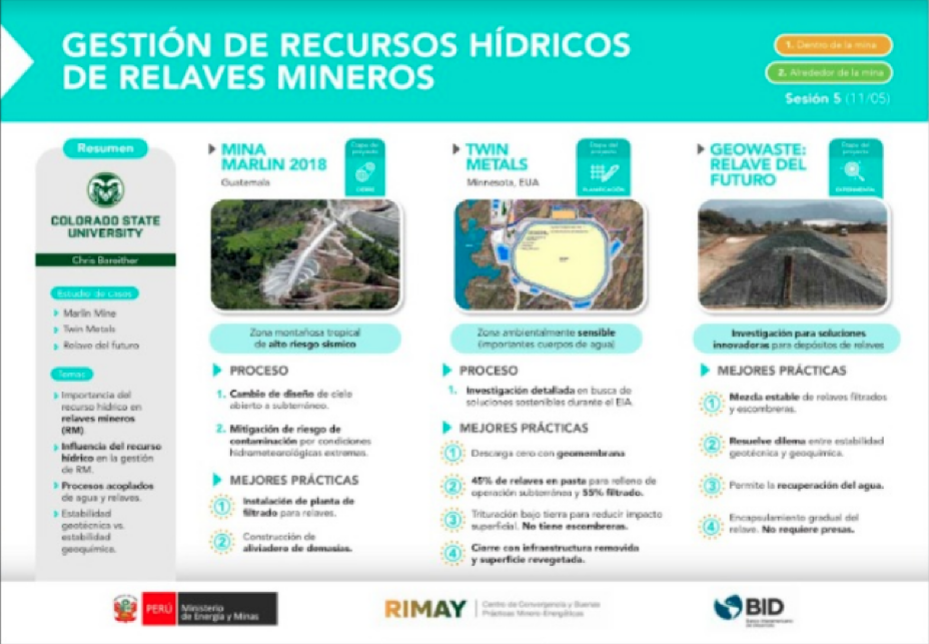PERUMIN HUB MINING INNOVATION IN PERU


CHALLENGESWATER RESOURCES
For the second consecutive year, the social license to operate in mining is considered the greatest risk faced by this industry worldwide and within this risk, the management of water resources is the second most influential factor.
In Peru, although mining uses only 1.5% of available water, it represents more than 65% of authorized industrial wastewater discharges.
How to optimize water use and its reuse in mining operations?
The Sustainable Development Goal 6 (Ensure the availability and sustainable management of water and sanitation) aims to significantly increase the efficient use of water resources in all sectors and ensure the sustainability of water extraction and fresh water supply to deal with water scarcity and significantly reduce the number of people suffering from water shortages.
Mining companies and allies look for technologies that consider one or more elements of value in their proposal:
Elements of value
Having a multisectoral vision (including, for example, the energy and/or agricultural sector and/or territorial (including not only the mine, but also the water sources and direct and indirect area of influence).
Taking advantage of the different water sources that may be undervalued, being efficient in capturing water and/or taking advantage of different water sources that may be undervalued.
Ensuring the quality of water in the discharge and post operations in a sustainable manner.
Aligned with Peruvian regulations, which facilitate/enable joint work with the ANA.
Incorporating water balance diagnosis with a basin approach and climate change projection.
Focused on circular economy that allows maximizing the number of times water is kept in the circuit, reusing it and admitting other types of water, such as groundwater.
Technologies that allow measuring: i) water use, ii) water losses due to evaporation, filtration and/or entrapment in tailings, iii) quantity and quality variables based on the supply Andean basins.
Focused on reducing consumption and loss (such as water evaporation).

How to promote an integrated and participatory water resources management?
The mining sector is expected to contribute to the integrated management of water resources (GIRH in spanish) since the degree of water stress in basins has been increasing. This is due not only to the growth of social and economic activities, but also to the low efficiency in the management of water demand, the low quality of water resources, the high vulnerability to climate change, the weak governance in the management of the resource, coupled with the asymmetric distribution of water in quantity and opportunity in the national territory.
One of the goals for 2030, within the framework of Sustainable Development Goal 6 (Ensure the availability and sustainable management of water and sanitation) is to implement integrated management of water resources at all levels. Integrated approaches help coordinate sustainable development and water management for the entire spectrum of users and/or stakeholders involved: community, agriculture, industry, mining, user committees, Ministry of Energy and Mining (MINEM), Ministry of Environment (MINAM), Ministry of Agrarian Development and Irrigation (MIDAGRI), National Authority of Water (ANA), local governments, etc.
Mining companies, government stakeholders and unions/associations seek models/mechanisms and/or systems that consider one or more elements of value in their proposal:
Elements of value
Contributing to the implementation of the Water Resources Management Plans of Basins (for Andean basins with existing), a binding public instrument that aims to achieve the sustainable use of water resources, as well as the increase in water availability in the short, medium and long term, in harmony with national, regional and local development. Currently there are 6 completed planes on the Pacific side: Tumbes, Chira-Piura, Chancay-Lambayeque, Chancay-Huaral, Quilca-Chili and Caplina-Locumba and the Amazon side planes are in the process of being updated: Mayo, Pampas, Vilcanota-Urubamba and Mantaro.
Making visible not only structural actions but also non-structural ones, to contribute promoting a culture of water management, considering the cultural diversity of the coastal, Andean and Amazonian populations, i.e Fundación Los Andes in Cajamarca, has the initiative of the Interactive Water and Land Museum (https://www.losandes.org.pe/museo-de-agua-y-tierra-interactivo/).
Risk management in the face of climate change (the south coast being the area most affected by water scarcity).
Providing analysis and value to existing mechanisms such as Basin Andean Councils.
Including friendly information for communities.
Considering the roles in participatory management: i) State as the manager of water resources and ii) private companies (mining and industry) as strategic collaborators for the management and implementation of solutions.
Making visible the contribution to water management and to the value chain, through friendly information for communities and other local stakeholders.
Solutions in the coastal zone.
Water sources as a base unit and an opportunity to expand information about them.
Circular approach.
Putting value on open information (open data) in a transparent manner with a focus on generating trust and raising awareness among users and/or stakeholders.
Homologation and validation of public information such as that of the ANA´s Water Observatory, SENAMHI´s Hydrometeorological Data, among others.
Systematization/centralization of climatological and hydrological information from all stations (public and private) for decision-making, preferably in real time.

How to make regulation processes more efficient, generating shared value between the mining company and the State?
Regulation is created to correct market failures such as the presence of externalities, the existence of public goods, competition failures, information asymmetry, among others. In turn, it is a key government tool to achieve social, economic, and environmental goals, among others. We seek solutions that facilitate regulation processes, generating value for the State, the territory and the mining company.
Mining companies and State stakeholders seek models/mechanisms and/or systems that consider one or more elements of value in their proposal:
Elements of value
Homologation and validation of public information such as that of the ANA´s Water Observatory, SENAMHI´s Hydrometeorological Data, among others.
Incentives that go beyond recognition and value good management practices to simplify processes. Currently the ANA has the Blue Certificate.
Putting value on open information (open data) in a transparent manner with a focus on generating trust and raising awareness among users and/or stakeholders.
How to include technological trends and the participation and collaboration of private companies (international benchmark) to improve existing regulations, promoting projects and generating shared value. In this line, an escalation of corporate water management could be mentioned, that is, making it easier for the mining company to manage water risks as part of the business strategy with innovations that allow it to evaluate, monitor and reduce the water footprint in its operations, but that in turn link the entire chain in their business model: partners, suppliers, collaborators and clients/beneficiaries with the reduction of the impacts they generate on water resources and generating spaces for collective management.

Additional information to inspire
Review the infographics of the best practices in management of water resources in mining identified by the Multi- stakeholder Technical Group of the Center for Convergence and Good Mining-Energy Practices -Rimay








